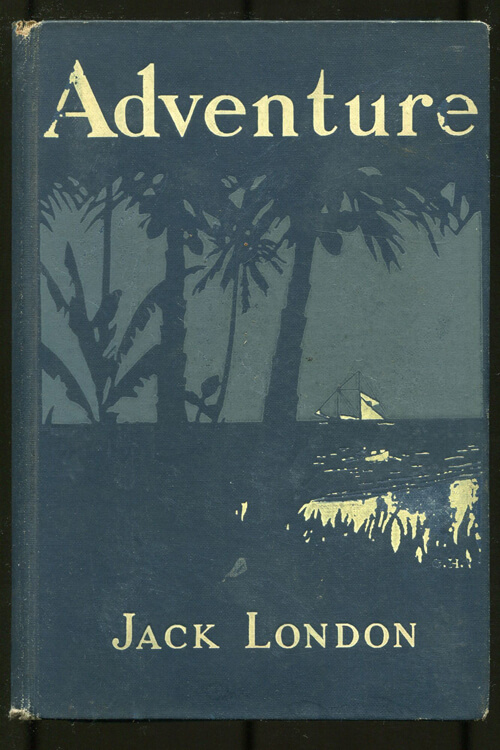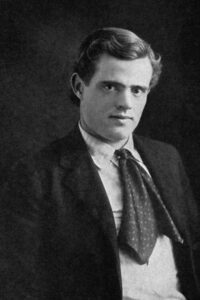
Adventure
He was a very sick white man. He rode pick-a-back on a woolly-headed, black-skinned savage, the lobes of whose ears had been pierced and stretched until one had torn out, while the other carried a circular block of carved wood three inches in diameter. The torn ear had been pierced again, but this time not so ambitiously, for the hole accommodated no more than a short clay pipe. The man-horse was greasy and dirty, and naked save for an exceedingly narrow and dirty loin-cloth, but the white man clung to him closely and desperately. At times, from weakness, his head drooped and rested on the woolly pate. At other times he lifted his head and stared with swimming eyes at the cocoanut palms that reeled and swung in the shimmering heat. He was clad in a thin undershirt and a strip of cotton cloth, that wrapped about his waist and descended to his knees. On his head was a battered Stetson, known to the trade as a Baden-Powell. About his middle was strapped a belt, which carried a large-calibred automatic pistol and several spare clips, loaded and ready for quick work.
The rear was brought up by a black boy of fourteen or fifteen, who carried medicine bottles, a pail of hot water, and various other hospital appurtenances. They passed out of the compound through a small wicker gate, and went on under the blazing sun, winding about among new-planted cocoanuts that threw no shade. There was not a breath of wind, and the superheated, stagnant air was heavy with pestilence. From the direction they were going arose a wild clamor, as of lost souls wailing and of men in torment. A long, low shed showed ahead, grass-walled and grass-thatched, and it was from here that the noise proceeded. There were shrieks and screams, some unmistakably of grief, others unmistakably of unendurable pain. As the white man drew closer he could hear a low and continuous moaning and groaning. He shuddered at the thought of entering, and for a moment was quite certain that he was going to faint. For that most dreaded of Solomon Island scourges, dysentery had struck Berande plantation, and he was all alone to cope with it. Also, he was afflicted himself.
By stooping close, still on man-back, he managed to pass through the low doorway. He took a small bottle from his follower and sniffed strong ammonia to clear his senses for the ordeal. Then he shouted, “Shut up!” and the clamor stilled. A raised platform of forest slabs, six feet wide, with a slight pitch, extended the full length of the shed. Alongside it was a yard-wide run-way. Stretched on the platform, side by side and crowded close, lay a score of blacks.
Read or download Book
Jack London
John Griffith Chaney (January 12, 1876 – November 22, 1916), better known as Jack London, was an American novelist, journalist and activist. A pioneer of commercial fiction and American magazines, he was one of the first American authors to become an international celebrity and earn a large fortune from writing. He was also an innovator in the genre that would later become known as science fiction.
London was part of the radical literary group “The Crowd” in San Francisco and a passionate advocate of animal rights, workers’ rights, and socialism. London wrote several works dealing with these topics, such as his dystopian novel The Iron Heel, his non-fiction exposé The People of the Abyss, War of the Classes, and Before Adam.
His most famous works include The Call of the Wild and White Fang, both set in Alaska and the Yukon during the Klondike Gold Rush, as well as the short stories “To Build a Fire”, “An Odyssey of the North”, and “Love of Life”. He also wrote about the South Pacific in stories such as “The Pearls of Parlay”, and “The Heathen”.
Family
Jack London was born on January 12, 1876. His mother, Flora Wellman, was the fifth and youngest child of Pennsylvania Canal builder Marshall Wellman and his first wife, Eleanor Garrett Jones. Marshall Wellman was descended from Thomas Wellman, an early Puritan settler in the Massachusetts Bay Colony. Flora left Ohio and moved to the Pacific coast when her father remarried after her mother died. In San Francisco, Flora worked as a music teacher and spiritualist, claiming to channel the spirit of a Sauk chief, Black Hawk.
Biographer Clarice Stasz and others believe London’s father was astrologer William Chaney. Flora Wellman was living with Chaney in San Francisco when she became pregnant. Whether Wellman and Chaney were legally married is unknown. Stasz notes that in his memoirs, Chaney refers to London’s mother Flora Wellman as having been “his wife”; he also cites an advertisement in which Flora called herself “Florence Wellman Chaney”.
Late in 1876, Flora Wellman married John London, a partially disabled Civil War veteran, and brought her baby John, later known as Jack, to live with the newly married couple. The family moved around the San Francisco Bay Area before settling in Oakland, where London completed public grade school. The Prentiss family moved with the Londons and remained a stable source of care for the young Jack.
Early life
London was born near Third and Brannan Streets in San Francisco. The house burned down in the fire after the 1906 San Francisco earthquake; the California Historical Society placed a plaque at the site in 1953. Although the family was working class, it was not as impoverished as London’s later accounts claimed. London was largely self-educated. In 1885, London found and read Ouida’s long Victorian novel Signa. He credited this as the seed of his literary success. In 1886, he went to the Oakland Public Library and found a sympathetic librarian, Ina Coolbrith, who encouraged his learning. (She later became California’s first poet laureate and an important figure in the San Francisco literary community).
In 1889, London began working 12 to 18 hours a day at Hickmott’s Cannery. Seeking a way out, he borrowed money from his foster mother Virginia Prentiss, bought the sloop Razzle-Dazzle from an oyster pirate named French Frank, and became an oyster pirate himself. In his memoir, John Barleycorn, he claims also to have stolen French Frank’s mistress Mamie. After a few months, his sloop became damaged beyond repair. London was hired on as a member of the California Fish Patrol.
First success
On July 12, 1897, London (age 21) and his sister’s husband Captain Shepard sailed to join the Klondike Gold Rush. This was the setting for some of his first successful stories. London’s time in the harsh Klondike, however, was detrimental to his health. Like so many other men who were malnourished in the goldfields, London developed scurvy. His gums became swollen, leading to the loss of his four front teeth. A constant gnawing pain affected his hip and leg muscles, and his face was stricken with marks that always reminded him of the struggles he faced in the Klondike. Father William Judge, “The Saint of Dawson”, had a facility in Dawson that provided shelter, food, and any available medicine to London and others. His struggles there inspired London’s short story, “To Build a Fire” (1902, revised in 1908), which many critics assess as his best.
His landlords in Dawson were mining engineers, Marshall Latham Bond and Louis Whitford Bond, educated at the Bachelor’s level at the Sheffield Scientific School at Yale and the Master’s level at Stanford, respectively. The brothers’ father, Judge Hiram Bond, was a wealthy mining investor. While the Bond brothers were at Stanford, Hiram at the suggestion of his brother bought the New Park Estate at Santa Clara as well as a local bank. The Bonds, especially Hiram, were active Republicans. Marshall Bond’s diary mentions friendly sparring with London on political issues as a camp pastime.






